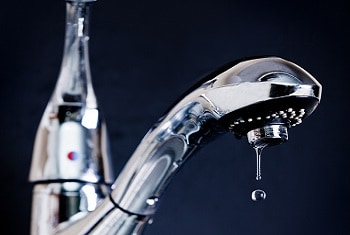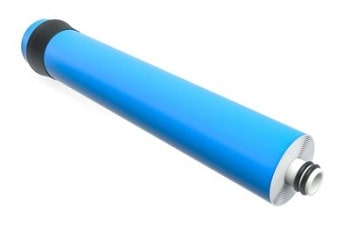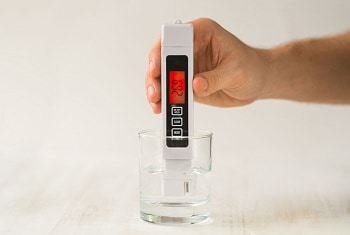There is a common misconception that reverse osmosis drinking water systems waste a large amount of water, but actually, if you consider what the reverse osmosis system is doing, the amount of water that is discharged to drain is not really all that bad.
A reverse osmosis system uses water to remove impurities from your water. Because this water is performing a useful function, it should not be considered to be wasteful. A reverse osmosis membrane uses water to reject impurities and rinse them to waste but that doesn’t mean that they are wasteful.
During the process of reverse osmosis, the untreated water coming into the system is forced through a semipermeable membrane which allows the smaller water molecules to pass through but rejects the larger molecules of unwanted dissolved solids in the water.
These rejected dissolved solids are rinsed away to waste. Some reverse osmosis systems can waste up to 75% of the original incoming water and some systems waste much less.
There are a few factors that can affect how wasteful a reverse osmosis system is.
The primary factor is the incoming water pressure.

The membrane of a reverse osmosis system works best when it has been compressed by incoming water. If the water supply going to the system is kept at the ideal pressure for the membrane to work best, there will be less water wasted to make quality filtered water.
A reverse osmosis drinking water system that has an electric pump with it will be able to deliver a more consistent flow of the correct pressure water for that particular system and therefore make the reverse osmosis membrane work more efficiently.
Although this does not necessarily mean that the system will use considerably less water, the system will work as efficiently as it possibly can.
The second factor is the condition of the reverse osmosis membrane.

All reverse osmosis membranes are designed to allow water molecules while rejecting larger, unwanted contaminants.
As the membrane ages or if it gets exposed to corrosive chemicals, the openings in the membrane can expand, letting more incoming water get through than it should.
This will create less waste of water, but it will also mean that the quality of the drinking water produced will be poor.
You should check the quality of your reverse osmosis water regularly with a TDS meter.

Check that your reverse osmosis water TDS (Total Dissolved Solids) content is at least 10% or less of your homes tap water. If the TDS is above 10% of the unfiltered water, you should change your filters and membrane.
See How Often Should You Change RO Filters? And How To Do It!
Why are some reverse osmosis systems more wasteful than others?
A reverse osmosis system needs to rinse away the impurities that have been rejected by its reverse osmosis membrane. Although this water is considered to be waste, it is necessary for the reverse osmosis process.
It’s not so much that some reverse osmosis systems are more wasteful, it’s just that some reverse osmosis systems are more efficient than others because the incoming water pressure is better or the water pressure is more consistent on the reverse osmosis membrane.
The process of reverse osmosis wastes more water than it produces, and if a system wastes less water than another, the quality of the water or longevity of the membrane might be less than other systems.
The use of a permeate pump for a reverse osmosis system is to relieve the back pressure created when the reverse osmosis system is filling the storage tank.
By balancing out the pressure before and after the reverse osmosis membrane, the system should produce a higher quality filtered water and waste as little water as possible.
How well a permeate pump works for reverse osmosis is still under debate, but I have seen substantial improvement in water quality and system efficiency with reverse osmosis systems that use a permeate pump.
What are the least wasteful reverse osmosis systems?
Oddly enough, I have found that the less expensive reverse osmosis drinking water systems are often the most efficient without having a loss of quality drinking water.
I have tested water from many different types of reverse osmosis drinking water systems and almost always, the more expensive systems that boast the most gadgets deliver the least amount of filtered water for the amount wasted.
There are a few expensive reverse osmosis systems out there that advertise that they waste less water than others, but I have found that the quality of the drinking water produced by these systems is equally not as good as a lower-priced system.
It seems that if you want to brag to your friends about having an expensive reverse osmosis drinking water system, you shouldn’t be concerned about the quality of the water that much.
But if you are just looking for high-quality drinking water, save your money and consider a reverse osmosis system that costs a few hundred dollars rather than a few thousand.
See my Recommended Reverse Osmosis systems
How much water does a reverse osmosis system waste?
Typically, a home reverse osmosis drinking water system will use about 3-4 gallons of water to rinse the unwanted contaminants from your water to waste for every 1 gallon of usable drinking water produced.
This amount will vary slightly from household to household depending on water pressure and type of system.
Some systems waste as little as 3 gallons of water for every 1 gallon of filtered water, but this difference is a minimal benefit in the long run.
When you consider all of the other ways that water is used to clean things around the home or get rid of household waste, the amount of water that a reverse osmosis drinking water uses to purify your water doesn’t seem like that much at all!
Think about how much water we use for everyday household activities!
| Water used for | Percentage of household water use | Average gallons used per use | Average gallons of water used per day | Fact |
|---|---|---|---|---|
| Toilet | 26.7% | 3.7 – 7 per flush | 37 – 70 gallons based on 10 uses | A toilet that doesn’t shut off correctly can waste about 200 gallons of water per day! |
| Showering | 16.8% | 2.1 per minute | 21 gallons for a 10 minute shower | Starting the shower 5 minutes before showering so the water gets hot wastes 10.5 gallons of hot water! |
| Washing machine | 21.7% | 27 – 50 gallons per load | 27 – 50 gallons based on just 1 load | A large family may average 2 loads of laundry per day which equals 280 gallons of water in a week! |
| Faucets | 15.7% | 2 gallons per minute | 18 – 27 gallons | Leaving a faucet on while shaving or brushing your teeth can waste up to 200 gallons of water per month per person! |
| Leaking water | 13.7% | 1+ gallons per hour | 26 gallons from toilets and faucets | One toilet that doesn’t shut off and one dripping faucet can waste as much as 364 gallons of water per week! |
| Miscellaneous | 5.3% | Varies | 21.2 gallons | Rinsing food, cooking, drinking water. |
| Reverse Osmosis System | 5.3% of 75 total gallons per day used on average. | Varies | 1 gallon of drinking water per person | Based on a person drinking 1 gallon of reverse osmosis water per day which requires 4 total gallons of water to produce. |
Is reverse osmosis wasteful compared to other uses of water?
I don’t think so!
Why are reverse osmosis systems wasteful?
A reverse osmosis drinking water system is designed to remove unwanted dissolved solids from your water. To do this, it has to separate the unwanted solids from the water and dispose of them by rinsing them away down the drain.
This is not technically wasting water as it is more simply using water to get rid of unwanted solids, just as you would use water to rinse off your car after washing it. So basically, a reverse osmosis system is not wasting water at all.
Check out this quick video about how reverse osmosis works!
Reverse osmosis water waste ratio.
Most reverse osmosis drinking water systems waste 3 gallons of water to produce 1 gallon of reverse osmosis filtered water. Source
Although there are reverse osmosis systems on the market that claim to have 2 to 1 or even 1 to 1 production water ratios, this often will reduce the lifespan of the filters and the reverse osmosis membrane.
The process of reverse requires some water to get through the reverse osmosis membrane, but most of the water to be rejected. Having the proper incoming water pressure will create the proper balance of the two.
The water pressure of the water entering a reverse osmosis drinking water system can affect the water waste ratio because the higher the water pressure is, the more water that can be forced through the reverse osmosis membrane before being rejected down the drain.
Is reverse osmosis wastewater safe to drink?

Although the exact contents of reverse osmosis water will vary from location to location, the wastewater discharged from a reverse osmosis drinking water is not considered to be healthy to drink.
A reverse osmosis system is designed to remove unwanted contaminants from the water in order for it to be safer and healthier for us to drink.
The wastewater that flushes away these unwanted contaminants may only have a small percentage more contaminants than the original water, but it is still not considered to be better than the original water.
BUT! In some cases, the water that is discharged by your reverse osmosis drinking water system may be just what you are looking for.
Many avid coffee drinkers find that water that is too pure often is not the best for brewing their favorite flavor of the coffee. And if your water is not particularly high in dissolved solids, to begin with, brewing coffee with the reverse osmosis wastewater may make your java taste better to you.
Without dissolved solids in water, it has very little taste or flavor at all.
Many coffee drinkers are used to using water that has a bit of flavor already in it to make their coffee and when they make it with reverse osmosis water that has virtually no flavor, their coffee seems weak and not full-flavored as they have come accustomed.
Since reverse osmosis waste-water will have more flavor than the original tap water, some coffee drinkers may find it more appealing in their coffee.
So, are reverse osmosis drinking water systems wasteful?
In my opinion, considering that a reverse osmosis system takes water that would normally be unhealthy to drink and filters out 95% or more of the dissolved solids contained in the water, I think that it doesn’t waste much water at all!
Just like washing a car or yourself, we use water to rinse away things that we want to get rid of. The water is used as a tool to complete a task, and in the case of a reverse osmosis drinking water system, it completes the task of creating quality drinking water very well.


How is it possible to avoid using the reversed osmosis water for the dishwasher?
Hello Ruth and thank you for the question.
Providing that your water will not damage your dishes if it does not go through your reverse osmosis system, you could have the water rerouted to your dishwasher before it goes through your reverse osmosis system but I would make sure that the water will properly clean your dishes and not cause any harm to your dishes or dishwasher before doing so.
I hope this was helpful
Paul